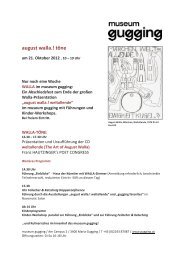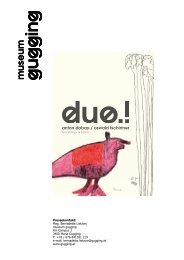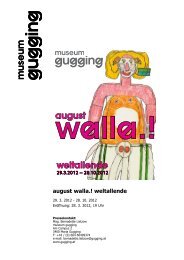august walla.! weltallende - Museum Gugging
august walla.! weltallende - Museum Gugging
august walla.! weltallende - Museum Gugging
Create successful ePaper yourself
Turn your PDF publications into a flip-book with our unique Google optimized e-Paper software.
Walla - an universal artist<br />
[<strong>august</strong> <strong>walla</strong>.! <strong>weltallende</strong>]<br />
August Walla was born in Klosterneuburg in 1936. During the Nazi era his mother raised<br />
him as a girl, hoping to spare her son being drafted into war one day. Later he became<br />
aware of his male identity. Looking back on his childhood, he decided that the Russian<br />
occupants must have operated on him, turning him into a “Russian boy”. Within the<br />
middle-class society of Klosterneuburg, mother and son Walla were notorious outsiders.<br />
For many years Walla lived in a small apartment together with his mother, once in a<br />
nursing home, then in a cottage on the Danube’s floodplain an finally in a dilapidated<br />
casern. In 1983 Leo Navratil offered him a room at the “Centre for Art-Psychotherapy”,<br />
the later House of Artists in <strong>Gugging</strong>. Walla lived and worked there until his death in<br />
2001, enjoying a growing reputation as an artist.<br />
Walla the Philosopher<br />
His works brim over with words, emblems and symbols. They are often centred on his<br />
self-made polytheist philosophy: a mysterious world populated by spirits with the prospect<br />
of a far-away Universe-End-Land, which may be either the realm of the dead, paradise,<br />
limbo or the great nothingness. The “Universe-End-Land” marks the transition to<br />
that successive cosmos. The gods residing there have names like Kappar (god of ghosts),<br />
Seiril, Sararill, also called Satttus, and are akin to the gods venerated by humans. Walla<br />
considered himself a Christian. He ascribed self-invented symbols to the gods and frequently<br />
used those in his drawings and his writing.<br />
Walla the Artist and the Painter<br />
August Walla was continuously writing or drawing. Wherever he went, he always had<br />
coloured pencils and paint on him. He created around 3000 drawings and 100 large<br />
canvases and produced etchings, which show his precise, prominent stroke most pronouncedly.<br />
Walla the Writer<br />
Walla wrote innumerable letters; to people he knew personally but also to various<br />
authorities. His communication with the “outside” world was mostly in writing as long<br />
as his mother was alive. He was a special kind of writer, obsessive, composing at least<br />
one letter a day. Every single one of his letters is written in his personal “typeface”,<br />
a calligraphic work of art, a gem from Walla’s Universe. He also used dictionaries in<br />
numerous languages to translate and construct words in his particular way. He invented<br />
many neologisms, which he integrated into his writing. The punctuation became most<br />
characteristic of his notation. He attached “.!” (full stop plus exclamation mark) to each<br />
and every heading or to his name.<br />
Picture Credit: Gaston Chaissac, Ohne Titel, 1943, Gouache auf Papier © VBK, Wien, 2011<br />
4






